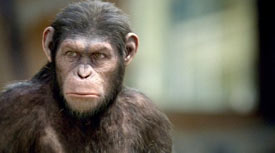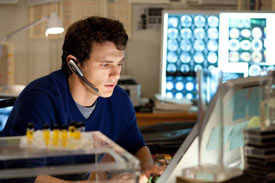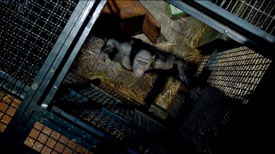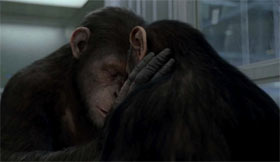

 - for intense and frightening sequences of action and violence.
- for intense and frightening sequences of action and violence.

An origin story set in present day San Francisco, where man's own experiments with genetic engineering lead to the development of intelligence in apes and the onset of a war for supremacy.
(from IMDB.com)
In 1968, director Franklin J. Schaffner introduced the world to a sci-fi film that would soon become a phenomenon. Planet of the Apes may not be a masterpiece, but it managed to spawn several sequels, as well as a 2001 remake starring Mark Wahlberg which was directed by Tim Burton. Now ten years later, director Rupert Wyatt takes on the challenge of rebooting the Planet of the Apes as a prequel to the original, showing movie goers just how those apes took over earth. What sounds like a corny and risky premise actually proves to work surprisingly well as Wyatt approaches the story through a more serious lens, casting James Franco as a scientist who is trying to find a cure for Alzheimer's through testing on chimps. A series of events then unfold that lead to an ape named Caesar being born with heightened intelligence.

The idea of Rise of the Planet of the Apes gives viewers every reason to be skeptical. However, Wyatt lays a great dramatic framework for the story. Franco plays the role of Will Rodman very serious and the story packs an unexpected emotional punch as Will desperately tries to find a cure for the debilitating disease that Alzheimer's is. It isn't too long before we discover that Will's father is living with him and suffering from the disease himself, and we then fully understand Will's passion for finding the cure. Wonderfully performed by John Lithgow, it's tempting to call his portrayal of a man battling with Alzheimer's Oscar worthy, especially as he bounces in and out of the disease at different times in the movie. When Will's test on the apes goes awry and his experimentation is shut down prematurely, he discovers that the test ape had unexpectedly given birth to a baby, which Will decides to take home to save it from being put down. Will's father names him Caesar and the film begins to follow the life of this ape... who incidentally inherited the drug Will administered to its mother at birth.
Most of the film follows a dramatic story before becoming a bit more of an action film near its finale. It may seem to some like Wyatt pulled a Michael Bay's The Island by mixing genres, but Wyatt never seems to turn the film into a mindless action flick (like Bay tends to). When the mayhem does ensue, it's part of the tension build of where this story is headed. We know the apes will inherit the earth, it's just that we don't know how it gets to that point, and the film does a real nice job setting that up. Caesar is very much a victim of circumstance and it's easy to feel for him. You see both where Will and Caesar are coming from, and it makes it more difficult to want to fault either of them. Still, when things start to come to a head before the credits role, it may seem hokey to some, but it's also when you need to remind yourself just exactly what kind of movie this is. Most of the film feels grounded firmly in reality, but as it builds closer to Planet of the Apes, that reality becomes less and less, and that is when the drama starts to feel more sci-fi in nature.
The company that worked on the motion capture visual effects for Avatar provided the effects for Rise of the Planet of the Apes. Andy Serkis, who is known for playing Gollum in the Lord of the Rings films and King Kong in the disappointing 2005 remake, provides the motion capture performance for the central ape, Caesar. Serkis does an incredible job and, coupled with the stellar effects, really brings Caesar to life and with a lot of character. However, at the same time, you can still tell Caesar and many of his monkey counterparts are digitally rendered. It's seldom that the characters seem photorealistic; as Caesar begins to look more human and less like an ape, the more "fake" he begins to look too. Still, it's a step in the right direction for the technology and it works better than simply having regular actors wear "monkey make-up." Hopefully the technology will only continue to improve, especially if more of these films are made.

The PG-13 rated content of Rise of the Planet of the Apes mostly deals with violence. There's a sickness element that may be disturbing to some (and I'm not really referring to the Alzheimer's aspect), but there's quite a bit of ape-related violence. One of the most intense scenes involves an ape biting a man's finger. The scene is quick and bloody, and it was my understanding that he literally bit the man's digit off, but later we see the man wearing a splint on the finger (meaning it couldn't have been removed). Also, we see a sick person who coughs and sneezes blood in two different instances, as well as another person who is electrocuted to death. Some apes are shot and people are mostly injured than killed (but there are a couple exceptions), and we see a dead body with some blood on their hand and head as they lay facedown on a bed. Profanity isn't too bad, considering, but there are still a few uses of blasphemy that really didn't need to be included.
As a prequel, Rise of the Planet of the Apes excels more than one can expect it to. It's arguably the best in the series to date, save for maybe the iconic original, but it's an intriguing and well-thought-out story that is well presented here, setting up for potential new sequels. I'm eager to see where this series is headed next.
- John DiBiase (reviewed: 8/9/11)
 Rise of the Planet of the Apes was a pleasant surprise at the theaters this summer. It's an excellent springboard for a potential new series of Apes movies and if a follow-up is anything like this one, it could be something really great. FOX releases Rise of the Planet of the Apes as a 2-disc Blu-Ray/DVD/Digital Copy combo pack (thankfully, FOX hasn't jumped on the Ultraviolet bandwagon), while those just wanting a DVD copy can grab one of those by itself. Along with the Blu-Ray release are quite a few bonus features...
Rise of the Planet of the Apes was a pleasant surprise at the theaters this summer. It's an excellent springboard for a potential new series of Apes movies and if a follow-up is anything like this one, it could be something really great. FOX releases Rise of the Planet of the Apes as a 2-disc Blu-Ray/DVD/Digital Copy combo pack (thankfully, FOX hasn't jumped on the Ultraviolet bandwagon), while those just wanting a DVD copy can grab one of those by itself. Along with the Blu-Ray release are quite a few bonus features...
Deleted Scenes (12:00) - There are eleven deleted scenes clocking in at a total of twelve minutes, so as you can imagine, each one is pretty short. The first one takes place when the apes are first captured and we see the "Alpha" get shot. What's strange about including this right off the bat is that the animation for the Alpha ape isn't finished... so we literally see a man in a gray motion capture suit galloping like an ape after the truck, and then getting shot down. The second one just shows Will having a meeting with his lab assistants. The next one features Will discovering that Caesar has solved some of his dad's puzzles and we see actor Andy Serkis in his motion capture suit instead of Caesar's animation. The fact we see it's Serkis and Franco actually acting together makes it all the more amazing that the two could act so convincingly together. Next is another scene with Caesar playing with a bicycle, but again it's all Serkis instead (until the end when we see a little finished animation). The next scene shows Serkis as Caesar seeing some teens without their shirts on playing in the street outside, so it causes him to take off his sweater and examine himself more closely in the mirror in his room. The next is an alternate version of a scene that's in the film where Caesar attacks their neighbor. In this version, he fully bites off the neighbor's finger instead of just biting it. It's ultimately the exact version that's seen in the film except that it's more evident that the man's finger is missing (and rather bloody). The seventh scene shows Serkis as Caesar strapped to a table and Rodney offers him a cookie. The next is a short scene where Dodge hoses down the ape Rocket (but both Rocket and Caesar are shown as the motion capture actors). The ninth scene shows Serkis trying to destroy the lab and leading the apes out, while Koba (also just the actor being shown) tries to get revenge on Jacobs, but Will intervenes. The next shot shows Caesar being the one that pushes the helicopter at the end instead of Koba. Lastly, we see a finished shot of Koba finding a shotgun and a bullet in the forest and figuring out how to load and fire it, acting as what would have been the final shot of the movie. It's a pretty menacing way to end the film as it starts to set up the future films more. All of the sequences with unfinished animation were a neat idea to include here, but it seems to detract from the "movie magic" of seeing the apes and characters acting in their respective scenes. Some scenes even have visible crew reflected in windows and mirrors, and varying degrees of completed effects. With how well this movie did in the theaters, you'd think they may have been willing to spend a few extra bucks to finish some of the effects for these scenes.
Mythology of The Apes (7:11) - The cast and crew of Rise of the Planet of the Apes reflect on the mythology of the previous films, starting with the 1968 original. We also hear from the crew about how they were inspired to create an origin for the iconic original film and then they point out some of the nods, easter eggs, and various homages that were paid to the previous films in Rise. This is a fun featurette to watch for anyone who's followed the previous films closely.
The Genius of Andy Serkis (7:48) honors the performance of actor Andy Serkis who first got into motion capture acting with the Lord of the Rings films as Gollum and acted out the role of Caesar for Rise of the Planet of the Apes. We see a lot of on-set footage of Serkis running around the set in his gray motion capture suit and even some side-by-side comparison shots of Serkis and the finished, animated Caesar. They talk about the great deal of work that had to be done to make the motion capture process work (including shooting scenes where Franco is acting with nothing there), while we also hear from much of the cast as they reflect on Serkis' brilliant performance.
A New Generation of Apes (9:41) focuses on what the animators went through to research their ape renderings and make them as accurate as possible. It goes pretty in-depth, even so far as to have one of the animators show the program they used on the computer and how they tried to capture the apes as realistic as possible. It's a fascinating featurette, especially from a technical standpoint.
Scene Breakdown - Using three different color buttons on your Blu-Ray remote, you can watch a scene from the film with Picture-In-Picture reference (red button), Early CG Animation (green), and the actors' Performance Capture (yellow button). Picture-In-Picture may be the coolest option because you really get to see how the animation compares to the genius of the actors' performances. The scene we get to watch is when Caesar hands out cookies to his fellow inmates.
Character Concept Art Gallery - This is a seemingly unfinished featurette that gives you a collage image of all of the main ape characters from the film. You can then click on each one individually and see a realistic photo of the kind of ape the character is based on, and then you can click the arrow button forward for another rendering of the film version of the animal. Each ape only has two photos, so it seems a little incomplete to me.
Breaking Motion Capture Boundaries (8:43) - This is a sweet featurette that reveals how they filmed the incredible climactic ape attack on the Golden Gate Bridge. They built a set outside, surrounded it with green screens and proceeded to have the largest motion capture filmed sequence to date--and done outside of a studio for the first time in daylight. A great deal of behind-the-scenes footage is shown here as well as just about every little trick they could have used to make this scene really come to life. It's amazing the work that went into that sequence.
Composing the Score with Patrick Doyle (8:07) - Composer Patrick Doyle talks about what it was like to score the film, including the challenges of having to make a score speak for scenes where there wasn't a lot of (or any) dialog. It's a great look into the depth of Doyle's work and all of the incredible talents, players, and vocalists that went into making this film. And I'll leave you with these five words: "I gotta cookie for ya."
The Great Apes (22:37) - This documentary is broken up into three parts with each one focusing on the different types of apes: Chimpanzee, Gorilla and Orangutan. This one is right up the alley of anyone wanting to know more about these animals.
There are two Audio Commentary tracks for the film: one from director Rupert Wyatt and another by writers Rick Jaffa and Amanda Silver, that both give further insight into the film. A theatrical trailer rounds out the last of the bonus features for this fairly well-loaded Blu-Ray release.
- John DiBiase, (reviewed: 12/13/11)
Disclaimer: All reviews are based solely on the opinions of the reviewer. Most reviews are rated on how the reviewer enjoyed the film overall, not exclusively on content. However, if the content really affects the reviewer's opinion and experience of the film, it will definitely affect the reviewer's overall rating.
 "HOPE" is Coming, Petra's First New Studio Album in 20 Years "HOPE" is Coming, Petra's First New Studio Album in 20 YearsWed, 24 Dec 2025 13:30:00 EST |
 John Schlitt Releases Limited Vinyl Edition of "The Christmas Project" John Schlitt Releases Limited Vinyl Edition of "The Christmas Project"Tue, 23 Dec 2025 18:00:00 EST |
 Elan Brio Shares His Passion, 'Written In Sound,' Alongside Nikkuubeats Elan Brio Shares His Passion, 'Written In Sound,' Alongside NikkuubeatsMon, 22 Dec 2025 14:20:00 EST |
 m1L and R.kitect Announce New EP and Lead Single m1L and R.kitect Announce New EP and Lead SingleMon, 22 Dec 2025 14:05:00 EST |
 "David," Starring Phil Wickham, Earns Highest-Grossing Faith-Based Animated Theatrical Opening of All Time "David," Starring Phil Wickham, Earns Highest-Grossing Faith-Based Animated Theatrical Opening of All TimeSun, 21 Dec 2025 16:05:00 EST |
 Phil Wickham Breaks Mediabase Record with No. 1 Song Phil Wickham Breaks Mediabase Record with No. 1 SongFri, 19 Dec 2025 18:10:00 EST |
 B. Cooper Releases New Single, "Back," ft. 350 B. Cooper Releases New Single, "Back," ft. 350Fri, 19 Dec 2025 17:25:00 EST |
 Click here All News Headlines |
Click here All News Headlines |